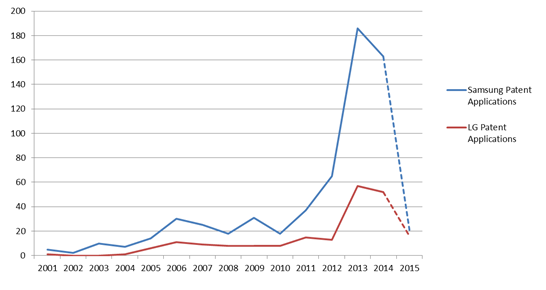Since 2001, the Korean government has kicked off three nation-level programs for flexible electronics (three-, five- and ten-year long) with a focus on the basic and fundamental research of OLED and flexible displays. By taking part in these programs, both Samsung and LG have made some breakthroughs in flexible AMOLED technology and have largely increased their patent filings with USPTO since 2012, according to MIC (Market Intelligence and Consulting Institute), an Taipei-based ICT research institute.
Number of Samsung and LG's Patent Applications for Flexible Displays

Note: As U.S. patent applications are automatically published after 18 months from their earliest priority date, those filed after mid-2014 might not have been published when this report was published, leading to statistical inaccuracy. Therefore, patent applications filed after mid-2014 are presented in dots.
Source: USPTO, compiled by MIC, January 2016
"Looking at Samsung's patent portfolios, the company has filed over 100 patent applications related to flexible AMOLED displays in 2013 and 2014 respectively. Most of them focused on improving the application of the display, such as product reliability and ease of operation," explains Chung-Yu Yang, industry analyst with MIC. "A closer look at the patent applications filed by Samsung also reveal the company's attempt to develop electronic devices that can perform different functions by changing the form of the display such as unlocking the screen or running a specific application when the curvature of the device is detected or enabling data entry through the combination of a curved screen and a motion detection sensor."
Meanwhile, according to the claimed functions in LG's patent applications, enhancing product reliability, especially panel degradation problems caused by bending, has continued to be the company's major challenge. However, unlike Samsung, LG has mainly focused on overcoming degradation problems such as wire disconnection or short circuits instead of improving image quality on the curved surface or enhancing the strength of the display during repeated bending. As repeated bending is likely to become a standard requirement in the future, rendering images during bending will be inevitable. Therefore, lightweight, thinness, ruggedness, or bezel-free design will continue to play a key role in LG's flexible display development.
To see more about this report, please visit: Development of Samsung's Flexible AMOLED Technology from Its Patent Portfolios and Development of LG's Flexible AMOLED Technology from Its Patent Portolios
For future receipt of press releases, or more information about MIC research findings, please contact MIC Public Relations.
As a New Year's special, MIC is giving away complimentary reports. Get your copies here (registration required):
Brand Competition and Consumer Preference of the Chinese LCD TV Market
Brand Competition and Consumer Preference of the Chinese Air Purifier Market
About MIC
Market Intelligence & Consulting Institute (MIC), based in Taipei, Taiwan, was founded in 1987. MIC is Taiwan's premier IT industry research and consulting firm providing intelligence, in-depth analysis, and strategic consulting services on global IT product and technology trends, focusing on markets and industries in Asia-Pacific. MIC is part of the Institute for Information Industry. https://mic.iii.org.tw/english